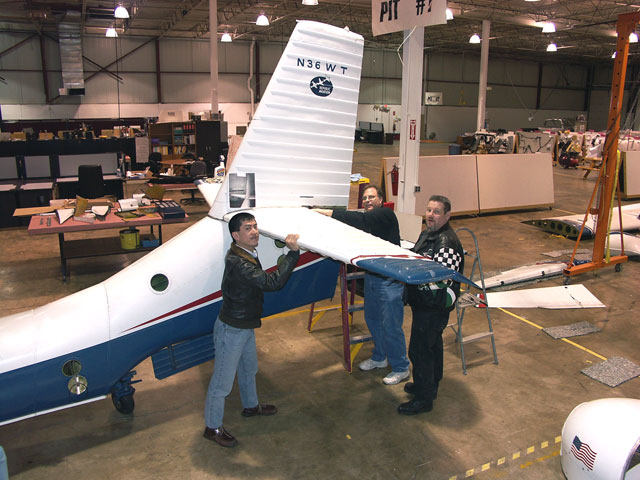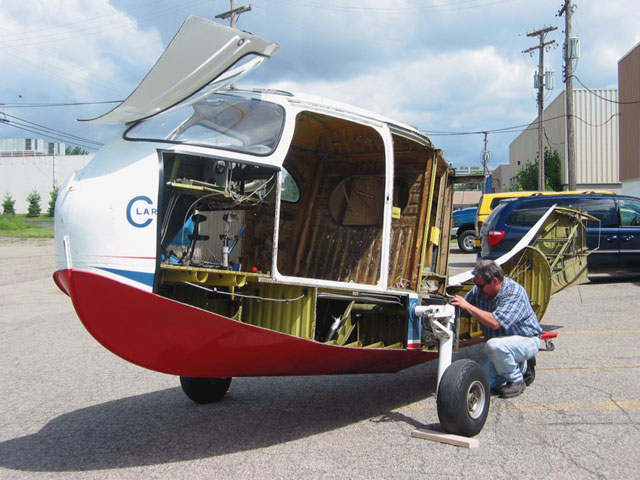When the Republic
Seabee amphibian was put into production in 1946, this was the
result of a design and development process never seen before in the aviation
history. For the first time an aircraft manufacturer seriously
looked to the automobile industry to take advantage of automotive design
and manufacturing methods for reducing production time and costs. The
first Seabee prototype, the RC-1 Thunderbolt Amphibian NX41816, was a concept
demonstrator made by conventional aviation construction methods. First
flight was made on 30 November 1944.
However, Republic Aviation's president Alfred Marchev, realized that if
Republic was going to win the expected post WW2 personal airplane market
boom, they had to make something different at a price affordable for the
masses. Marchev ordered a complete redesign of the Seabee to
reduce the cost dramatically. The seemingly impossible goals
Marchev set for his engineers were: a four seat amphibian aircraft
at a sales price of $ 3.500 - the conventional prototype would have an
estimated sales price of $ 13.000!
The
engineers took the challenge. Several changes were made; the
tapered cantilever wings were replaced by constant chord strut braced
wings, the partly buried retractable wheels of the RC-1 were replaced
by wheel retracted in the free air. Number of parts were reduced
substantially by introducing deep die press forming methods from the automotive
industry, and wherever possible automotive parts and components were
used in favor of overpriced aviation industry parts. In order to
reduce the costs of the engine installed, Republic even acquired the
engine manufacturer. Republic also negotiated large quantity rebates
from the vendors.
Unfortunately,
several factors made big problem for the Seabee production and sales.
Important manufacturing tools such as sheet metal presses got delayed
from the tool subcontractors, material and labor costs increased
forcing Republic to increase sales price twice in less than a
year. Production deliveries got delayed and production rates were
never even close to the original goal of making 400 Seabees per month -
5.000 in one year. In June 1947 Republic was forced to stop production
when sales failed, after only one and a half year and 1060 built.
On 2 October 1947 Republic announced that the Board had made the final
decision to terminate the Seabee project in favor of military aircraft
such as the new F-84 Thunderjet fighter jet.
Then - more than a half a century
later - NASA started to look into the future transportation systems.
It is realized that in the future it might be necessary to transfer
more of the personal transportation from the roads to the air, to
avoid further congestions. NASA initiated a number of projects
to develop Singe Engine Propeller aircraft for future personal use -
the Personal Air Vehicle (PAV) concept. Three factors were
identified as the main barriers preventing widespread adoption of SEP
aircraft for personal transportation; (1) Ease of Use (2) Pollution
and (3) Cost. NASA research projects were started to research possible
solutions to overcome all these barriers.
Cost was ranked as the third most important of all
of the barriers preventing widespread adoption of SEP aircraft for
personal transportation. This is because it is the other measure that
ultimately determines value and also determines the actual size of the
market. Mode choices that are low cost, but of little value or are
high value but high cost are both limited in total market size. Even
if the EoU and Pollution PAV priorities increase the utility of the
SEP aircraft, the cost is much too high for a new, invigorated market
to take off. Kraus noted that cost cutting of up to 20% during the
1980s had very little effect on sales. What is needed is a rebalancing
of design priorities in favor of radical reductions in cost at much
higher levels of production, keeping in mind that the market will have
to bootstrap itself up, meaning that there has to be a path from
relatively low rates of production through to historically high rates
of production.
Since the PAV sector intended to address cost
through design, it was necessary to first determine where the major
cost items were and then propose approaches to address them.
It is immediately obvious that labor and engine
account for nearly 50% of the price, that profit accounts for 25%, and
that incidentals account for about 15%. Since price reductions of 20%
are ineffective, and both profit and incidentals cannot be affected by
design, the only option was to make radical cuts in labor and engine
costs.
Labor Cost - A survey of historical best practices
in aircraft production brought to NASA's attention the construction
and production methods that Republic Aviation used on their RC-3
Seabee model. Most aircraft manufacturers believed that there would be
unprecedented increased civilian demand and the normal dramatic drop
in military demand for aircraft after World War II ended. After having
produced more P-47 Thunderbolts than any other American fighter type
(15,686), Republic was in possession of a wealth of production time
and material cost data, so a small group of engineers analyzed this
data to see where cost could be taken out. They quickly realized that
building a civilian aircraft the way that they currently did was going
to be prohibitively expensive, so they decided to use a radical
construction method proposed by Alfred Boyajian that used deeply
formed, heavy gage skins with few internal parts. Nearly all of the
internal structure was replaced by deeply formed skins, and all
fastening was accessible by semiautomatic riveting guns from the
outside.
This was a complete departure from the conventional
construction of many interlocking internal parts that required hand
assembly, usually with poor access for fastening . Republic’s
attention went well beyond simply reducing part count and fastening
accessibility. They realized that operations, like heat treating,
assembly, disassembly, deburring, reassembly, and manual
multi-operation tooling reduced productivity unacceptably and
unnecessarily. They compromised the structural material strength for
better formability without any post treatment operations. They used
semi-automatic riveting guns that clamped and punched holes in parts
before upsetting the rivets instead of drilling so that disassembly
and deburring and reassembly operations would be eliminated. They even
designed and built their own automated wing assembly machine that was
able to fasten the wing primary structure together in minutes.
While the greatest impact of this philosophy was
felt on the flying surfaces, as much of it as possible was also
applied to the fuselage, yielding large cost reductions there as well.
All of this attention to detail and design for automated assembly
yielded an overall airframe part reduction of 75% and a labor
reduction of 92% with an increase in tooling cost of 100%.
Republic found that for simplified design and
aircraft tooling, there is an immediate 38% cost reduction due to the
lower part count, compared to conventional design and aircraft tooling.
However, when comparing the airframe cost per pound as a function of
units produced, the slope of the curve is essentially the same. This
means that the increased productivity with increasing units is limited
by the aircraft tooling.
The lowest curve is for the simplified design and
automotive type tooling. While there is an immediate increase of 25%
in cost because of the increased tooling cost, the curve is on a
completely different slope, paying off dramatically in productivity as
units increase. It is this improved learning curve that holds the most
promise for reducing PAV costs. There are two more important points to
be made about these curves. First, even at only 100 units per year,
the simplified design with automotive tooling is lower cost than the
conventional design. Second, the increased tooling costs are more than
made up for by productivity at approximately 150 units per year.
While this is a lot of units for most manufacturers
in today’s market, this low rate needed for breakeven makes
bootstrapping the market very plausible.
The NASA PAV sector adopted the Republic Aviation
philosophy as a baseline, and worked with others to verify these
assumptions. Munro and Associates, experts in lean design for the
automotive industry, has been branching out into the aviation
industry. They were funded to perform the same disassembly and cost
analysis for the Republic Seabee that they do for major automotive
manufacturers. Much to their surprise, they were very impressed with
the Seabee design. They did have constructive input on potential
improvements, particularly with respect to modern fastening options
like laser weld bonding and friction stir welding, but the overall
philosophy and implementation was judged excellent. Munro came to the
conclusion that the sale price for this fairly high performance
aircraft would be about $100,000, with standard avionics, at
production rates of 4000 units per year. If true, this would be an
excellent value and leave a large budget for those willing to upgrade
to the NFD and H-mode avionics.
You can learn more
about PAVs at http://cafefoundation.org

N36WT (s/n 1054)
at Munro & Associates
Troy, Michigan
16 March 2004
Photo: © M&A via Maverick Yamamoto
MISATS – The
Michigan Small Aircraft Transportation System is a non-profit,
government-industry-university consortium formed to transfer select
commercial and automotive technologies to general aviation applications.
Once developed, these technologies will be integrated into the SATS
national research program. Innovations developed by MISATS will be eligible for
commercialization by private companies with competitive business models.
These companies will then be positioned for leadership in a revitalized
and a commercially viable general aviation industry.
MISATS is a
contributor to the long-term NASA SATS vision of a National personal air
transportation system that is safer and more efficient than the current
commercial air travel system. SATS is a long range national vision with
objective spanning out 25 years. The NASA goal is to reduce inter-city
travel times by half in 10 years, and by two-thirds in 25 years.
NASAs strategy
for general aviation revitalizations of aviation industry is
challenging. The plans calls for the delivery of up to 20000 aircraft in
20 years, with some very demanding parameters. Aircraft price and cost
of operation must be slashed dramatically, but improve performance and
safety and vastly simplifying their operation.
Munro &
Associates started MISATS with the NASA approved goal to demonstrate
that automotive style systems integration, Six Sigma quality, Lean
Design and lean manufacturing can radically reduce aircraft complexity,
while revolutionizing safety, efficiency and affordability.
MISATS operates
under the long term objectives that; aircraft can be designed and
manufactured at unit cost comparable to automobiles.
Select
technologies can be common between automobiles and general aviation
aircraft.
The innovations
and technologies being developed by MISATS are aimed at small aircraft
private and business commercial smaller airports around the country.
MISATS is the
only SATS program working to improve the
viability of the general aviation business model through aircraft
design, manufacturing, training and infrastructure.
Ultimately,
MISATS plans are launching a compelling three year air vehicle design
and fabrication program. The goal is to build a flying demonstrator that
with the transition into a business venture that can provide these
vehicles to the nation.

N36WT (s/n 1054)
at Munro & Associates
Troy, Michigan
18 March 2004
Photo: © M&A via Maverick Yamamoto

N36WT (s/n 1054)
Munro & Associates; Troy, MI, USA.
March 2004
Photo: © M&A via Maverick Yamamoto

N36WT (s/n 1054)
at Munro & Associates
Troy, Michigan
14 July 2004
Photo: © M&A via Maverick Yamamoto
Thank you very much, M&A and Maverick Yamamoto,
for supplying this story and the great images of Seabee s/1054
dissected!